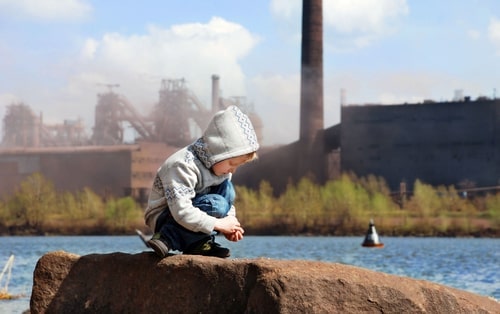Advice
The effects of air pollution on children

Whether it’s from industry, vehicle emissions, or wildfire smoke, just about all children are exposed to air pollution — including fine particles that can enter the lungs, bloodstream, and even the brain. What are the health effects of air pollution on children? And what can we do to protect our kids?


When young children are exposed to polluted air – including particulate matter (PM) – they don’t just suffer from respiratory problems. They are also more likely to develop chronic inflammation and risky health conditions associated with inflammation. Moreover, air pollution has been linked with adverse birth outcomes, accelerated cellular aging, abnormal lung development, and reductions in white and grey brain matter.
So it’s important for us to keep track of the threat that polluted air poses, and to remember the basic, biological facts that make kids especially vulnerable: Their bodies are still developing, and they actually breathe more air — per unit body weight — than adults do (Brumberg et al 2021).
Here’s an overview of what we know about dirty air and the effects of air pollution on children.
Understanding air pollution: What are the major pollutants?
Air pollutants include a wide range of noxious substances, including
- nitrogen oxides (NO2, NO);
- carbon monoxide (CO);
- black or elemental carbon;
- ozone (O3);
- polycyclic aromatic hydrocarbons (PAH);
- sulfur dioxide (SO2);
- heavy metal toxins, like lead and cadmium;
- volatile organic compounds (VOC), including the “BTEX” chemicals — benzene, toluene, ethylbenzene, and xylene; and
- particulate matter (PM2.5, PM10).
The last of these – particulate matter – refers to the tiny particles found in dust, dirt, soot, and smoke. These particles can be made up of all sorts of things, and they may carry toxic “hitchhikers,” such as arsenic or lead (Schraufnagel et al 2019). The smallest particles – those 2.5 microns in diameter – are often abbreviated as “PM2.5”, and they are among the most harmful components of air pollution.
What are the sources of this air pollution?
One of the most pervasive sources – found just about everywhere – is Traffic-Related Air Pollution, or “TRAP”. The combustion of fuel from motor vehicles fills the air with particulate matter made up of black carbon, toxic metals, and PAHs. Traffic also kicks up dust on the road, as well as particles shed by the friction of tires and brakes (Brumberg et al 2021).
Other sources of air pollution include coal-burning power plants, wood-burning stoves, animal agriculture (including emissions from manure), fracking, mineral dust (from both deserts and human industrial activity), and wildfires (Brumberg et al 2021; Urrutia-Pereira et al 2021).
How do we measure air pollution? How much pollution is there?
To evaluate air quality, scientists use devices that continually sample the air and then report the amount of a pollutant (measured in micrograms) found in one cubic meter or air.
Ideally, we want this measurement — micrograms per cubic meter (μg/m3) — to be as low as possible, day after day. But as a practical matter, governments and agencies set an upper limit for what is considered “safe.”
For instance, consider fine particulate matter pollution — particulate matter with diameters ≤ 2.5 μm, also known as “PM2.5”.
As of 2024, the U.S. Environmental Protection Agency has set the standard that the average daily PM2.5 should not exceed 9 μg/m3, and many U.S. cities are failing to make the grade. In 2023, Columbus, Ohio had the worst daily average among large U.S. cities — 14.2 μg/m3.
But local conditions can far, far exceed this amount if you happen to be close to the source of pollution.
This includes being stuck indoors with people smoking cigarettes, for example. In one study, researchers found that some smokers’ homes had indoor PM2.5 levels exceeding 100 μg/m3 (Semple et al 2015).
It also includes being exposed to smoke from a wildfire. In September 2020 during massive Oregon wildfires, my local air quality for PM2.5 was more than 400 μg/m3 — temporarily the worst in the world (Filonchyk et al 2022).
As you might expect, there is also a lot of variation worldwide.
Chronic levels of industrial pollution range widely. As per data collected in 2018, the Indian city of Delhi had the worst numbers for particulate matter with diameters ≤ 2.5 μm (PM2.5), averaging 113.5 μg/m3 (Rodríguez-Urregoa et al 2020). At the other end of the spectrum, cities in Switzerland typically average less than 5 μg/m3 (Grange et al 2021).
So how does air pollution affect children’s health?
The quick, high-level answer is that fine particles enter the body through the air passages, and they cause damage. Some of it is mechanical, and these effects are easy to imagine.
For example, when inhaled particles are very small – 2.5 microns or less in diameter – they can irritate the mucous membranes of the nasal cavity, triggering a runny nose and cough.
In addition, these fine particles can make their way into the lungs, causing inflammation there. As a result, PM2.5 air pollution puts children at higher risk for developing respiratory illnesses, and researchers have observed this in populations around the world.
In one analysis, researchers found that for every 10 μg/m3 increase in annual average PM2.5 concentration, kids had a 12% higher risk of experiencing acute lower respiratory tract infections, which include pneumonia, acute bronchitis, whooping cough, and the flu (Mehta et al 2013).
But respiratory symptoms and problems represent the tip of the iceberg!
When fine particles cause damage to our air passages, this can trigger immune responses that impact other organs and systems in the body.
Moreover, fine particles don’t just get into our airways and lungs. It’s possible that some particles – including “ultrafine” particles that are just 0.1 microns or less in diameter — can pass through lung tissue and into the bloodstream (Basith et al 2022). It’s also possible that particles can make their way into the digestive tract as a result of getting swallowed.
By these means, particulate matter can affect much more than a child’s respiratory system. Scientists are still putting together the evidence, trying to understand the precise mechanisms.
But it seems clear that particulate matter can contribute to inflammation in the lungs and digestive tract, and these instances of local inflammation can trigger the immune system to go into “overdrive” – releasing pro-inflammatory cytokines throughout the body. In this way, air pollution can impact many organs, including the heart and brain (Schraufnagel et al 2019; Ha 2020).
This likely explains why air pollution is linked with such a broad array of inflammation-related health conditions, including cardiovascular diseases and diabetes. In addition, pollutants may cause harm via other routes, including direct damage to the DNA.
Let’s take a closer look at some of these additional problems. This isn’t an exhaustive list by any stretch of the imagination. But it highlights some of the biggest concerns.
Harming babies before they are born: The effects of air pollution on birth outcomes
For decades, studies have tracked birth outcomes among pregnant women exposed to air pollution, and the overall trend is clear: Air pollution, like PM2.5 and sulfur dioxide, is linked with miscarriage, low birth weight, and preterm birth (Brumberg et al 2021; Nyadanu et al 2022; Lee 2021; Veber et al 2022).
How sizeable is the effect of air pollution on adverse birth incomes?
For many infants, the effect may be small, but of course it depends on how polluted the air actually is. A few years ago, Saskia van der Zee and colleagues helped put this into perspective by comparing the risk of prenatal PM exposure to the risk of prenatal cigarette smoke exposure.
The researchers calculated that for every 10 µg/m3 increase in PM2.5 concentration, the risk of premature birth was heightened by an amount equivalent to having your mother smoke approximately three additional cigarettes per day (van der Zee et al 2016).
The effects of air pollution on cellular aging


When pregnant mothers are exposed to high levels of air pollution, their babies’ blood may show signs of something called oxidative stress – the damaging effects of free radicals that tend to “age” our cells.
In particular, newborns exposed to prenatal air pollution tend to have shorter telomeres – the molecular bumpers that cap our chromosomes and protect our DNA. When telomeres get attacked by free radicals, they lose some of their length, and this is considered a marker of premature cellular aging (Isaevska et al 2021).
Why should we care? Shortened telomeres and accelerated cellular aging are linked with the earlier onset of age-related health problems, including diabetes, cancer, and heart disease (Moix et al 2024).
Effects of air pollution on the cardiovascular system
Air pollution is linked with cardiovascular problems in adults, including hypertension, blood clots, and stroke (Qin et al 2022; Zhang, Wang et al 2022; Juneja Gandhi et al 2022; Wang et al 2022).
What about kids? Studies indicate that long-term exposure to PM2.5 pollution is associated with elevated childhood blood pressure and increased rates of hypertension (Kim et al 2020).
In addition, researchers suspect that early exposure to PM2.5 and other forms of air pollution may set children up for adverse cardiovascular events (like blood clots and stroke) later in life (Kim et al 2020).
Air pollution and infant gut biome
We carry an ecosystem of microbes in our digestive tracts, and these gut flora have an impact on our health. For example, there are microbe species that appear to promote inflammation and heighten our risk for obesity, insulin resistance, and diabetes. Others have beneficial effects, including a tendency to decrease inflammation.
So it’s interesting to note that air pollution can alter the composition of our gut flora – reducing some species and boosting others. It’s been documented in experiments on rodents, and clinical studies suggest that this happens in humans as well.
Most recently, researchers examined the gut flora of 103 healthy, 6-month-old babies and found links with air pollution: Infants who had been exposed to higher levels of particulate matter hosted greater quantities of Dialister and Dorea, microbe species associated with systemic inflammation. In addition, high exposure to PM2.5 was linked with lower quantities of Phascolarctobacterium – a microbe that reduces inflammation (Bailey et al 2022).
What about neurological development? Does air pollution affect a child’s brain?
The blood-brain barrier helps protect the brain from contact with damaging molecules. But some air pollution particles are small enough to break through the barrier.
In fact, the tiniest particles (dubbed “ultrafine,” with diameters not exceeding 0.1 microns) may reach the brain by going directly through the nose and into the olfactory nerve (Elder et al 2006). Indeed, this route has been documented in experiments on nonhuman animals (Qi et al 2022).
And air pollutants can cause trouble indirectly as well – by causing inflammation in other parts of the body, like the lungs or digestive tract, and subsequently triggering a general immune response: chronic, systemic inflammation (Peeples 2020; Ramírez-Mendoza et al 2024).
What are the long-term consequences?
That isn’t entirely clear, not yet.
Brain scan studies suggest that early life exposure to TRAP (traffic-related air pollution) is linked with reductions in both white and grey brain matter (Ha 2021).
In addition, long-term exposure to TRAP and PM2.5 has been associated with poorer academic performance — even after accounting for socioeconomic factors (Lam et al 2023; Stenson et al 2021).
And many studies have reported links between early life air pollution and a variety of cognitive, emotional, behavioral, and neurological problems (Ha 2021).
For example, when researchers scanned the brains of more than 400 kids living in the Netherlands, they found that higher exposure to air pollution (during pregnancy and childhood) was linked with thinning in the
-

 Destination8 months ago
Destination8 months agoSingapore Airlines CEO set to join board of Air India, BA News, BA
-

 Breaking News10 months ago
Breaking News10 months agoCroatia to reintroduce compulsory military draft as regional tensions soar
-

 Gadgets3 months ago
Gadgets3 months agoSupernatural Season 16 Revival News, Cast, Plot and Release Date
-

 Tech News12 months ago
Tech News12 months agoBangladeshi police agents accused of selling citizens’ personal information on Telegram
-

 Productivity11 months ago
Productivity11 months agoHow Your Contact Center Can Become A Customer Engagement Center
-

 Gadgets3 weeks ago
Gadgets3 weeks agoFallout Season 2 Potential Release Date, Cast, Plot and News
-

 Breaking News10 months ago
Breaking News10 months agoBangladesh crisis: Refaat Ahmed sworn in as Bangladesh’s new chief justice
-

 Toys12 months ago
Toys12 months ago15 of the Best Trike & Tricycles Mums Recommend























